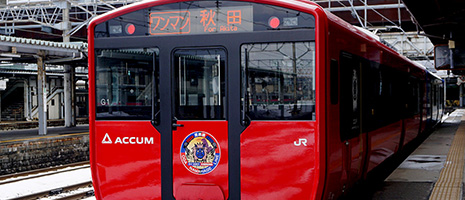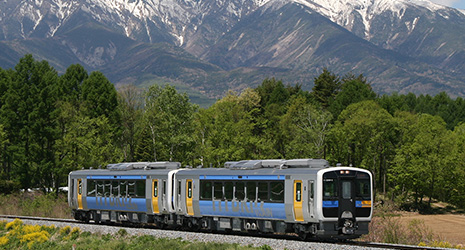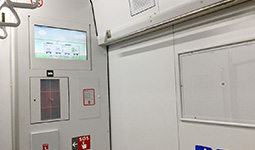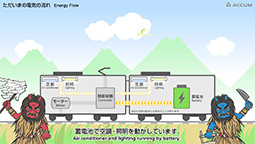Home > Highlighting JAPAN > Highlighting Japan April 2017 > Science & Technology
Highlighting JAPAN


Reinventing the Train
Railway engineers in Japan are working to reduce the environmental impact of trains running on their lines.
According to the Ministry of Land, Infrastructure, Transport and Tourism, the CO2 emissions in 2014 per volume of traffic (passenger) was 133 for private cars, 99 for airplanes and 22 for trains (unit: g-CO2/passenger kilometer). Many railway companies are working on a range of technological developments to further reduce this burden on the environment.
One challenge that East Japan Railway Company (JR East) is working on is the reduction of environmental loads in non-electrified sections of the railway. Normally, trains are powered by overhead wires that transmit power via pantographs installed on railcars in electrified sections. On the other hand, in non-electrified sections, trains typically run on diesel and thus emit exhaust gases such as nitrogen oxides and particulate matter. To solve this problem, in 2003 JR East started to develop diesel-electric hybrid railcars and in 2007 achieved the world’s first commercial operation of the trains on the non-electrified Koumi Line connecting Yamanashi and Nagano Prefectures.
Conventional railcars are driven by diesel engines powering the wheels, but hybrid railcars use their diesel engines to drive power generators and are additionally equipped with motors and lithium-ion storage batteries. When hybrid railcars start to run, their motors are driven by storage battery-charged power. As they accelerate, the hybrid railcars’ diesel engines kick in and join the work driving the motors. When hybrid railcars brake, the motors become power generators and the energy created is stored in batteries. This diesel hybrid system reduces fuel consumption rates by about 10% and NOx and PM emissions by about 60% compared with conventional models. Subsequently, hybrid railcars have started to operate as tourist trains running in areas including Nagano and Aomori Prefectures, and as railcars on the Senseki-Tohoku Line in Miyagi Prefecture.
In 2008, JR East started to develop storage-battery-driven electric railcars that could run in both electrified and non-electrified sections using large capacity lithium-ion storage batteries fitted into the floors. This system enables railcars to run on power gained from overhead wires, just like conventional trains in electrified sections, and also to recharge the storage batteries mainly with the energy produced by regenerative braking. The system can run using only that stored power by laying down pantographs in non-electrified sections.
After long-term test runs, a storage-battery-driven electric car nicknamed “ACCUM” started commercial operation on the Karasuyama Line (EV-E301 series) in Tochigi Prefecture, in March 2014, and the Oga Line (EV-E801 series) in Akita Prefecture, in March 2017.
“Of course, our primary development objective is to reduce environmental loads, such as CO2 and noise, but we can produce other advantages,” says Masashi Tonosaki, manager of the JR East Rolling Stock Technology Center. “Both hybrid railcars and storage-battery-driven electric railcars have something in common with ordinary trains in terms of the drive system for transmitting power from the inverters to the motors to the wheels. However, the number of machine parts in the engine and transmission is lower than in conventional electric-diesel railcars, meaning less maintenance work.”
When storage-battery-driven electric railcars reach a terminal station in non-electrified sections, they raise their pantographs and carry out rapid recharges for about ten minutes or slightly longer through special overhead wires through which larger currents than usual can be run. This full charge enables storage-battery-driven electric cars to run across the non-electrified sections ahead by motor. LED is used for all interior lights to curb power consumption. Bogies are fitted in the front and rear parts of the railcar. The lithium-ion storage batteries that enable storage-battery-driven electric railcars to run in non-electrified sections are situated under the car floor between these bogies.
“What we found to be most difficult about the development was the reinforcement required to bear that heavy weight and secure the strength of the railcar. At the same time, we have to keep the weight of the reinforcement down,” says Tonosaki. “It was very difficult to optimize the structure of the railcar body to accomplish these two contradictory goals.”
JR East has set a goal of reducing energy consumption in its railway business by 6.2% from 2013 to 2020. JR East will continue to develop railcars that can further reduce environmental loads to achieve this numerical target.
© 2009 Cabinet Office, Government of Japan








